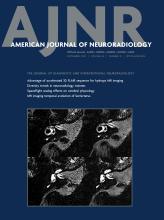Research ArticleAdult Brain
Open Access
Longitudinal Changes in Cerebral Perfusion, Perivascular Space Volume, and Ventricular Volume in a Healthy Cohort Undergoing a Spaceflight Analog
J.B. Tidwell, J.A. Taylor, H.R. Collins, J.H. Chamberlin, G. Barisano, F. Sepehrband, M.D. Turner, G. Gauthier, E.R. Mulder, D.A. Gerlach and D.R. Roberts
American Journal of Neuroradiology September 2023, 44 (9) 1026-1031; DOI: https://doi.org/10.3174/ajnr.A7949
J.B. Tidwell
aFrom the Department of Radiology and Radiological Science (J.B.T., J.A.T., H.R.C., J.H.C., M.D.T., G.G., D.R.R.), Medical University of South Carolina; Charleston, South Carolina
J.A. Taylor
aFrom the Department of Radiology and Radiological Science (J.B.T., J.A.T., H.R.C., J.H.C., M.D.T., G.G., D.R.R.), Medical University of South Carolina; Charleston, South Carolina
H.R. Collins
aFrom the Department of Radiology and Radiological Science (J.B.T., J.A.T., H.R.C., J.H.C., M.D.T., G.G., D.R.R.), Medical University of South Carolina; Charleston, South Carolina
J.H. Chamberlin
aFrom the Department of Radiology and Radiological Science (J.B.T., J.A.T., H.R.C., J.H.C., M.D.T., G.G., D.R.R.), Medical University of South Carolina; Charleston, South Carolina
G. Barisano
bLaboratory of Neuroimaging (F.S.), University of Southern California, Los Angeles, California
F. Sepehrband
cDepartment of Neurosurgery (G.B.), Stanford University, Stanford, California
M.D. Turner
aFrom the Department of Radiology and Radiological Science (J.B.T., J.A.T., H.R.C., J.H.C., M.D.T., G.G., D.R.R.), Medical University of South Carolina; Charleston, South Carolina
G. Gauthier
aFrom the Department of Radiology and Radiological Science (J.B.T., J.A.T., H.R.C., J.H.C., M.D.T., G.G., D.R.R.), Medical University of South Carolina; Charleston, South Carolina
E.R. Mulder
cDepartment of Neurosurgery (G.B.), Stanford University, Stanford, California
D.A. Gerlach
cDepartment of Neurosurgery (G.B.), Stanford University, Stanford, California
D.R. Roberts
aFrom the Department of Radiology and Radiological Science (J.B.T., J.A.T., H.R.C., J.H.C., M.D.T., G.G., D.R.R.), Medical University of South Carolina; Charleston, South Carolina

References
- 1.↵
- 2.↵
- 3.↵
- Roberts DR,
- Asemani D,
- Nietert PJ, et al
- 4.↵
- 5.↵
- Van Ombergen A,
- Jillings S,
- Jeurissen B, et al
- 6.↵
- 7.↵
- 8.↵
- 9.↵
- 10.↵
- 11.↵
- Traon PL,
- Heer M,
- Narici MV, et al
- 12.↵
- 13.↵
- 14.↵
- 15.↵
- 16.↵
- 17.↵
- 18.↵
- 19.↵
- 20.↵
- 21.↵
- Fischl B
- 22.↵
- 23.↵
- 24.↵
- 25.↵
- Sawilowsky SS
- 26.↵
- Kramer LA,
- Hasan KM,
- Sargsyan AE, et al
- 27.↵
- Kawai Y,
- Doi M,
- Setogawa A, et al
- 28.↵
- 29.↵
- 30.↵
- 31.↵
- Zamboni P,
- Menegatti E,
- Weinstock-Guttman B, et al
- 32.↵
- 33.↵
- 34.↵
- 35.↵
- 36.↵
- 37.↵
- 38.↵
- Murthy G,
- Marchbanks RJ,
- Watenpaugh DE, et al
- 39.↵
- 40.↵
- Mader TH,
- Gibson CR,
- Pass AF, et al
- 41.↵
- 42.↵
- Strangman G,
- Bevan G
In this issue
American Journal of Neuroradiology
Vol. 44, Issue 9
1 Sep 2023
Advertisement
J.B. Tidwell, J.A. Taylor, H.R. Collins, J.H. Chamberlin, G. Barisano, F. Sepehrband, M.D. Turner, G. Gauthier, E.R. Mulder, D.A. Gerlach, D.R. Roberts
Longitudinal Changes in Cerebral Perfusion, Perivascular Space Volume, and Ventricular Volume in a Healthy Cohort Undergoing a Spaceflight Analog
American Journal of Neuroradiology Sep 2023, 44 (9) 1026-1031; DOI: 10.3174/ajnr.A7949
0 Responses
Jump to section
Related Articles
- No related articles found.
Cited By...
This article has not yet been cited by articles in journals that are participating in Crossref Cited-by Linking.
More in this TOC Section
Similar Articles
Advertisement











